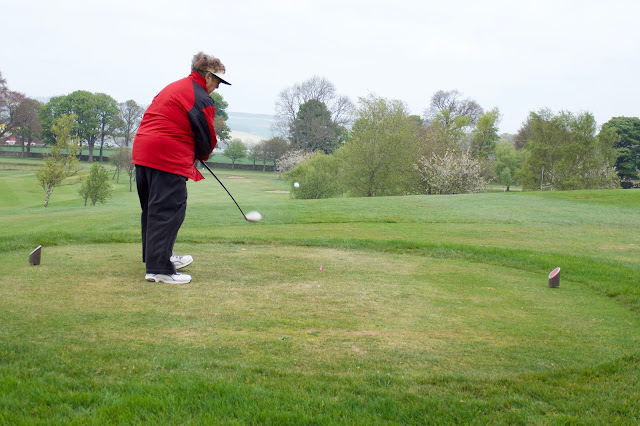After a week of golf in the Scottish highlands (stories to come later), we hit the A9, M9, M80, M73, M74, and the M6 to end up four and a half driving hours later in Yorkshire, England. We had planned three full days in Yorkshire—days filled with abbeys, castles, cheese factories, hills, and, of course, the Yorkshire Dales.
In this post I’ll present three brief encounters and two highlights of our Yorkshire experience.
Pet Rescue. Coming into Skipton-on-Swale we saw two signs: on the right side of the road was a sign for a “Pet Rescue” facility. Across the road from that sign was a sign for “Pet Crematorium.” Be rescued or else!
Coloured-blind Yorkshire. In Yorkshire we saw a newly painted grey and black pub/hotel with a sign in front: “Old Red House.”
Where’s the Fire? Walking into downtown Ripon one night for our evening meal we were passed by two fire trucks, lights and sirens blazing and blaring, heading out of town. Three minutes later the two trucks came back to us, blazing and blaring, heading now into town. Had they been lost? Could they not find the fire?
A minute or two later we turned a corner to see another fire truck pulling in to join the previously seen trucks on the main street of the village—all with lights flashing.
Firemen from the three trucks were hustling about in obvious confusion. Was there really a fire? What alarm had called three trucks? Was this really a game of “Where’s Waldo?” Or was the scene just an update version of the Keystone (fire) Cops?
We never did find out.
A Day of Indecision. Our plan for one day in Yorkshire was a drive through the North Yorkshire Moors National Park to Scarborough—that would have been a faire trip—but it was raining hard and the traffic was terrible. I pulled off the road and after a short consultation with Madame Navigator we turned around and drove to Castle Howard about 15 miles north of the City of York.
Castle Howard, not really a castle but an English Country House, was begun in 1699 and is now “one of Britain’s finest stately homes.”
 |
| Getting off the tractor/tram from the Visitor Centre to the castle. |
The 18th century residence, designed by Sir John Vanbraugh on a 1000 acre estate, is filled with art and interesting architecture.
The house and estate have been used in several films, including “Lady L,” “Brideshead Revisited,” and “Victoria.” Today you can take High Tea in the castle’s cafe.
Anne and I had a very enjoyable tour of Castle Howard while the rain pelted down outside.
Next, we started toward Scarborough on a shorter route, but following a farm implement at five miles and hour made us rethink that decision. Without much discussion we turned south toward York—we’ll save Scarborough for another trip.
 |
| The York Minster |
We parked in the York park-and-ride, got on the bus into town, and shortly were entering the the famous York Minster (cathedral). We toured the cathedral marveling at the architecture and history on display.
 |
| Figures of English Kings |
 |
| Sign in the loo in the York Minster: We knew that Boring, Oregon, had been twinned with Dull, Scotland (been to both), but we had no idea that anyone would "twin" a toilet. |
After the cathedral Anne and I stopped at Betty’s Tearoom to share a light lunch before wandering the shopping district
and the famous area known as the Shambles, where upper floor hang out over the street.
Changing our travel plans is not something we do often, but this day it was the right thing to do.
A Night on the Moors. I had wanted to do this ever since I found out about the place. We had to book months ahead, but we were both looking forward to a night on the Yorkshire moors at the famous Tan Hill Inn,
the highest inn in Britain at 1732 feet (528 m) above sea level. The inn was built in the 17th century and was used in the 18th century by workers in the areas coal pits.
 |
| The road into the moors from Swaledale. |
 |
| The North Yorkshire moors. |
Today, Tan Hill Inn stands isolated on the heights of the moorland, but at one time it would have been surrounded by miners’ cottages. These were demolished in the 1920’s, and the inn has since stood as a lone sentinel on the road crossing the moor.
 |
| Path from the Penine Way to the Tan Hill Inn. |
The inn is refuge for walkers trekking the Penine Way (267 miles of trail from the Peak District through the Yorkshire Dales), cyclists (bike and motorcycle), and the odd tourist (like us) seeking the interesting and the out-of-the-way.
 |
| Where's Anne? |
Open all year round, the inn uses two large generators for electrical power and serves full pub meals (good food) and B&B breakfasts—seven double and twin rooms are available, even if they are rather rustic.
Isolated and rustic though the inn is, it is a friendly place in a lovely setting—very popular for Christmas and New Years. We loved the moors, the inn, the people (both staff and other travelers), and would plan another visit to the Tan Hill Inn.
NEXT: More stories from our trip after we get home in a week and recover enough from jet lag to think again.
















































